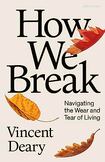
Reaching breaking point or burnout happens to us all. While unique in how it manifests, “breaking” depends on the failure of the very systems that once supported our ability to cope. In his new book, sequel to How We Are, British health psychologist Dr Vincent Deary reminds us, in the manner of a cosy dialogue between fellow travellers, that the experience of breaking is shaped by a unique interplay of factors, ranging from genes and luck to “toxic” environmental exposures.
When it comes to considering the stories that have shaped us, Deary does not limit his investigation to the shortcomings of our parents, in classic Freudian fashion. Instead, he invites us to look beyond “the usual suspects” to relationships with our peers, unfortunate life events, and the broader socioeconomic and political landscape.
After we’ve had a leisurely amble (or perhaps a frantic sprint) through the garden of our past, the psychologist encourages us to tune in to the energy-draining “hum” of precarity in our surroundings. Next comes his invitation to the reader to conduct their own “rhythmanalysis” – a measure of the degree to which the demands of our environments are out of sync with our “exquisitely balanced” biological rhythms.
On some level, How We Break is a reverberation of a time-worn story: human distress as the interaction of biology with environment. It distinguishes itself by playing with chronic illness and burnout from an internal perspective, exploring what it is like to inhabit that liminal state – no longer the person you once were and not yet the person you could become. He breathes new life and texture into the biology of breaking by equating joy with a “harmony of rhythms” and suffering with their life-derailing asynchrony.
Speaking not just from his clinical expertise but also from his experience of coming close to the brink, Deary extols the benefits of opting for a gentler, more forgiving pace of life, one that honours the internal rhythms of our physiology rather than the external demands of our productivity-driven culture. He does so while carefully refraining from separating distress from “its environmental, economic, and political determinants”.
While never quite resolving the dilemma between an exhausting world and a population of energy-limited, rest-averse human beings, this serves as a much-needed counterpoint to one of the warped tenets of self-help culture: the notion that “life never gives us more than we can handle”.





